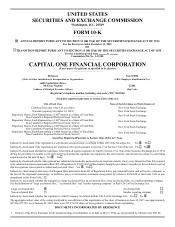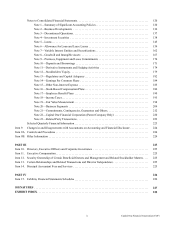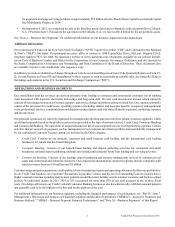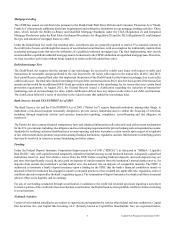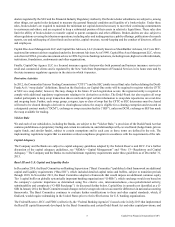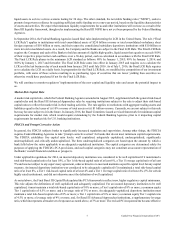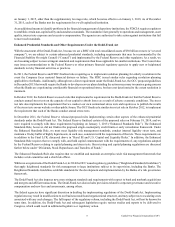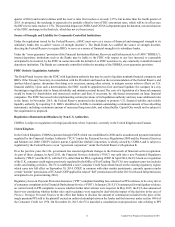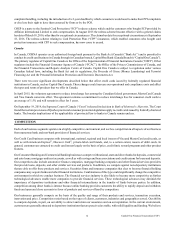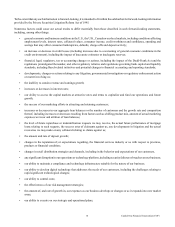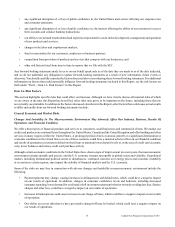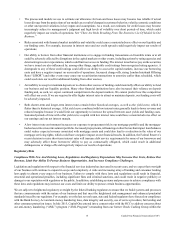Capital One 2015 Annual Report Download - page 26
Download and view the complete annual report
Please find page 26 of the 2015 Capital One annual report below. You can navigate through the pages in the report by either clicking on the pages listed below, or by using the keyword search tool below to find specific information within the annual report.7 Capital One Financial Corporation (COF)
liquid assets to survive a stress scenario lasting for 30 days. The other standard, the net stable funding ratio (“NSFR”), seeks to
promote longer-term resilience by requiring sufficient stable funding over a one-year period, based on the liquidity characteristics
of assets and activities. We expect that minimum liquidity requirements for us and other institutions will increase as a result of the
Basel III liquidity framework, though rules implementing the Basel III NSFR have not yet been proposed by the Federal Banking
Agencies.
In September 2014, the Federal Banking Agencies issued final rules implementing the LCR in the United States. The rule (“Final
LCR Rule”) applies to institutions with total consolidated assets of $250 billion or more or total consolidated on-balance sheet
foreign exposure of $10 billion or more, and their respective consolidated subsidiary depository institutions with $10 billion or
more in total consolidated assets. As a result, the Company and the Banks are subject to the Final LCR Rule. The Final LCR Rule
requires the Company and each of the Banks to hold an amount of eligible high-quality, liquid assets that equals or exceeds 100%
of their respective projected net cash outflows over a 30-day period, each as calculated in accordance with the Final LCR Rule.
The Final LCR Rule phases in the minimum LCR standard as follows: 80% by January 1, 2015; 90% by January 1, 2016; and
100% by January 1, 2017 and thereafter. The Final LCR Rule came into effect in January 2015 and requires us to calculate the
LCR as of the last business day of each month from January 2015 until July 2016. As of July 1, 2016, the Final LCR Rule requires
us to calculate the LCR on a daily basis. In preparation for the Final LCR Rule, we modified the composition of our investment
portfolio, with some of those actions resulting in us purchasing types of securities that are lower yielding than securities we
otherwise would have purchased if not for the Final LCR Rule.
We will continue to monitor regulators’ implementation of the new capital and liquidity rules and assess the potential impact to
us.
Market Risk Capital Rule
A market risk capital rule, which the Federal Banking Agencies amended in August 2012, supplements both the general risk-based
capital rules and the Basel III Advanced Approaches rules by requiring institutions subject to the rule to adjust their risk-based
capital ratios to reflect the market risk in their trading activities. The rule applies to institutions with aggregate trading assets and
liabilities equal to the lesser of (i) 10% or more of total assets or (ii) $1 billion or more. Currently, we are not subject to this rule
but may become subject to it in the future. In January 2016, the Basel Committee issued a revised framework for minimum capital
requirements for market risk, which would require rulemaking by the Federal Banking Agencies prior to it impacting capital
requirements for market risk for U.S. banking institutions.
FDICIA and Prompt Corrective Action
In general, the FDICIA subjects banks to significantly increased regulation and supervision. Among other things, the FDICIA
requires Federal Banking Agencies to take “prompt corrective action” for banks that do not meet minimum capital requirements.
The FDICIA establishes five capital ratio levels: well capitalized; adequately capitalized; undercapitalized; significantly
undercapitalized; and critically undercapitalized. The three undercapitalized categories are based upon the amount by which a
bank falls below the ratios applicable to an adequately-capitalized institution. The capital categories are determined solely for
purposes of applying the FDICIA’s PCA provisions, and such capital categories may not constitute an accurate representation of
the Banks’ overall financial condition or prospects.
Under applicable regulations for 2014, an insured depository institution was considered to be well capitalized if it maintained a
total risk-based capital ratio of at least 10%, a Tier 1 risk-based capital ratio of at least 6%, a Tier 1 leverage capital ratio of at least
5% and was not subject to any supervisory agreement, order or directive to meet and maintain a specific capital level for any capital
measure. An insured depository institution was considered to be adequately capitalized if it maintained a total risk-based capital
ratio of at least 8%, a Tier 1 risk-based capital ratio of at least 4% and a Tier 1 leverage capital ratio of at least 4% (3% for certain
highly rated institutions), and did not otherwise meet the definition of well capitalized.
As noted above, the Final Basel III Capital Rule updated the PCA framework to reflect new, higher regulatory capital minimums.
This rule adjusts the definitions of well capitalized and adequately capitalized. For an insured depository institution to be well
capitalized, it must maintain a total risk-based capital ratio of 10% or more; a Tier 1 capital ratio of 8% or more; a common equity
Tier 1 capital ratio of 6.5% or more; and a leverage ratio of 5% or more. An adequately-capitalized depository institution must
maintain a total risk-based capital ratio of 8% or more; a Tier 1 capital ratio of 6% or more; a common equity Tier 1 capital ratio
of 4.5% or more; a leverage ratio of 4% or more; and, for Basel III Advanced Approaches institutions, a supplementary leverage
ratio, which incorporates a broader set of exposures as noted above, of 3% or more. The revised PCA requirements became effective


